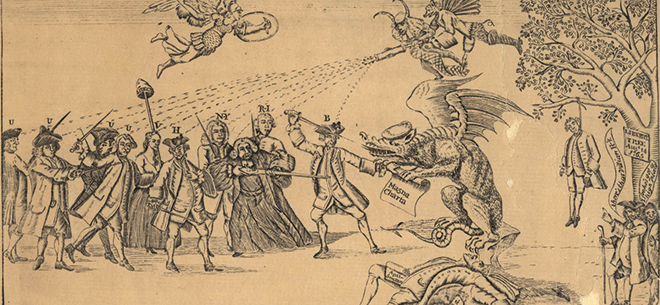Remembering a long-forgotten flash point for revolutionary fervor

While the much-anticipated annual celebration of the anniversary of the famed Boston Tea Party is nearly upon us, another flash point for revolutionary fervor that even longtime Bostonians may only recognize as the name of a suburban mall has nearly been forgotten. The Liberty Tree—a symbol of the colonists’ fight against oppressive British rule that was cut down by the Redcoats in 1775 at the outset of the open hostilities that marked the beginning of the American Revolution—leaves behind a legacy that is a vital benchmark in the history of this country.
A grand elm near Boston Common, the tree that would become famous more than a century later was planted in 1646 and stood in a prominent spot near the main road in and out of town. It became America’s first symbol of resistance in 1765 when effigies of local tax collector Andrew Oliver and a British leader were hung from its branches in protest of the Stamp Act, which imposed a levy on a variety of paper goods. Not long after this, a bronze plaque declaring the elm the “Tree of Liberty” was attached to it.
In the ensuing decade before the break from Britain, many other protests, along with meetings of the clandestine, rebellion-minded Sons of Liberty, took place at the Liberty Tree. It also inspired the naming of similar trees in other colonies, and anti-British proclamations were often affixed to its bark. When the Stamp Act was repealed in 1766, a celebration took place at the tree, and lanterns were hung from its boughs. In 1768, when Founding Father John Hancock’s ship was seized, an angry mob stole the boat of a customs commissioner, staged a mock trial in front of the tree and burned the vessel on Boston Common. In 1770, the tree was included in the funeral procession for the victims of the Boston Massacre, and, at the outbreak of war in 1775, writer and revolutionary Thomas Paine penned an ode to the tree, further spreading its renown.
Once the physical tree was gone, its symbolic presence continued to be felt for years, cited in quotes by both Thomas Jefferson and the Marquis de Lafayette. Over time, however, even after not one, but two markers were erected in its honor—one an 1850s bas relief on the building on the corner of Washington and Essex streets that sits at the former site of the tree, another a bronze plaque embedded in the sidewalk across the street more than a century later—the Liberty Tree became a distant memory. An aluminum sculpture representing the tree was included at the New England Pavilion of the 1964 World’s Fair in New York, and it stood for a time on Boston Common before being removed to its namesake shopping center in nearby Danvers, Mass. in 1972. Even that work of art has become forgotten, though, as it was removed without ceremony about 30 years ago, never to be seen again.


